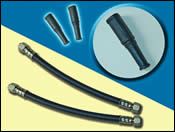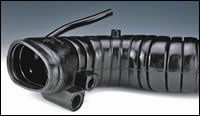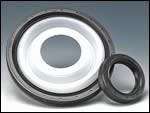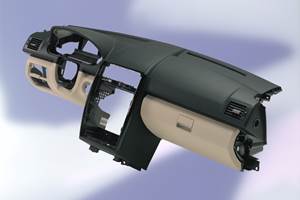'Super-TPVs': The New Challenge to Rubber
Recent commercialization of a cluster of novel thermoplastic vulcanizate (TPV) families is promising to boost demand for thermoplastic elastomers in new and challenging industrial and consumer product segments.
Recent commercialization of a cluster of novel thermoplastic vulcanizate (TPV) families is promising to boost demand for thermoplastic elastomers in new and challenging industrial and consumer product segments. One evolving class is “super-TPVs” designed to replace higher-cost thermoset rubbers and upgrade the performance of conventional TPVs in more extreme applications, notably auto under-hood, appliance, and industrial parts subjected to high heat (135 to 170 C) in the presence of oils and greases.
Conventional TPVs combine a PP matrix and a vulcanized EPDM rubber phase. The new “super-TPVs” create an analogous structure, but do so by utilizing wholly different components. To illustrate, the initial member of this new class, introduced two years ago by Dow Corning, consists of a cross-linked silicone rubber embedded in a nylon or TPU matrix. More recently, variations of this “thermoplastic silicone vulcanizate (TPSiV) family based on other engineering thermoplastic matrices are being developed for future launch. (TPSiV is now supplied by Multibase, a compounder purchased by Dow Corning.) Furthermore, the “super-TPV” category was recently broadened by the arrival of new members from Zeon Chemicals and DuPont Engineering Polymers.
A second new class of TPVs is also emerging to fill a mid-range performance level. These retain PP as the matrix, but incorporate a styrenic elastomer as the vulcanized rubber segment. Families of this kind have recently been introduced by Teknor Apex and, in masterbatch form, by Goodyear Chemical. These TPVs improve compression set, oil resistance, and adhesion of conventional TPVs and are aimed at overmolded high-performance grips, seals, and diaphragms.
Going under the hood
DuPont has recently unveiled its “engineering TPV” (ETPV) family combining a copolyester matrix material with a highly cross-linked rubber as the vulcanized segment. The rubber is AEM, a modified ethylene-acrylate. DuPont’s ETPV can be molded or extruded and is offered in 60 and 90 Shore A grades, both standard and heat-stabilized. The former sustain oil resistance at 150 C for over 1000 hr; the latter do likewise over 3000 hr. DuPont ETPV is commercially used in spark-plug boots, truck air-brake hose, and fuel-vent hose. Other promising applications are ducting, ignition seals, body plugs, and CVJ boots.
“Forces prompting development of ETPVs are increased electrical needs in under-hood areas and tougher vapor-emissions standards, both of which increase thermal load on engines and under-hood parts,” says Nandakumar Rao, DuPont’s global director for technology. DuPont ETPVs are said to offer excellent resistance to engine fluids at temperatures from -40 to 160 C. Ongoing tests at up to 180 C reportedly show favorable results.
An early success for these products is the fuel-vapor tube developed by Teleflex Fluid Systems for a 2005 vehicle. ETPV is used in the exterior layer of a three-layer tube that comes in direct contact with high engine temperatures and fluids. The structure also includes a core layer of a vapor-barrier material and a conductive inner layer. The design reduces emissions and cuts cost compared with the thermoset rubber tubing it replaces. ETPV’s elasticity facilitates installation with barbed connectors.
About 18 months ago, Zeon Chemicals introduced a super-TPV combining nylon 6 as matrix with a cross-linked polyacrylate (ACM) rubber (future grades will use a copolyester matrix). “The 100-series Zeotherm TPVs dramatically improve resistance to heat and oils,” says Brian Cail, Zeon’s new-business manager. He says the new grades withstand hot-oil immersion at 150 C over 3000 hr and also survive 175 C temperature spikes.
“Another rationale for using our TPVs is their bonding performance,” adds Cail, who claims outstanding adhesion strength for the materials when overmolded on unfilled, reinforced, and high-temperature nylons. Zeon currently offers 80 and 90 Shore A versions, and a 70A grade is in the pipeline. They are aimed at dynamic seals, electrical connectors, ducting, CVJ and rack-and-pinion boots, media filtration devices, and non-automotive connectors. An initial commercial use is an under-hood boot for a European 2005 vehicle.
According to Cail, comparative testing shows that Zeon’s TPVs beat competing TPSiV materials in heat resistance in the presence of hot fluids. He argues that a majority of under-hood applications require that combination of properties.
Lucrece De Ridder, Dow Corning’s global marketing manager for industrial and consumer markets, responds that the firm offers a number of different TPSiV compositions to meet different application requirements. Certain grades, she says, do provide excellent heat resistance in the presence of hot fluids. For example, Titeflex Corp. of Springfield, Mass., replaced steel-wire-braided PTFE automotive brake and fuel hoses with a nylon-based TPSiV grade. The result, says De Ridder, was improved abrasion resistance, good flame retardancy, kink resistance, and corrosion protection of the steel braid, plus significant improvements in processing that cut scrap and overall cost.
Other TPSiV grades have been engineered for communication devices, consumer goods, and medical devices. One example is the recent commercialization of mobile-phone covers made of TPSiV, which reportedly outperformed other materials with a combination of high-temperature resistance, low-temperature flexibility, superior abrasion resistance, good bonding to thermoplastic substrates in two-shot molding, weathering resistance, colorability, and processability (reduced cycle times). Another factor, says De Ridder, was TPSiV’s “unique dry, silky touch.”
Styrenic TPVs emerge
Goodyear has just introduced a new cross-linked elastomer in pelletized masterbatch form for use as a tool to address deficits of conventional olefinic TPV and SEBS-type TPEs, namely poor oil resistance and compression-set resistance at high temperature. Goodyear’s new Serel masterbatches are a solution styrene-butadiene rubber (SSBR) in a PP carrier. When blended with PP or SEBS, the SSBR would create hybrid TPVs featuring improved compression set, oil resistance, and wet coefficient of friction compared with conventional TPEs. Long-term bonding strength in overmolding is also said to be improved. Serel comes in pre-cross-linked and cross-linkable forms and can be tailored for different types (e.g., peroxide) and levels of cross-linking.
“Compounders can formulate grades with improved performance for grips and seals while retaining such TPE benefits as reduced cycle times and design flexibility,” says Meg Noethen, Goodyear’s TPE business manager. Targets include power tools and seals for water and sewer pipe, windows, and watercraft.
Meanwhile, Teknor Apex has developed a high-performance TPV using PP as the matrix, but substituting a hydrogenated styrenic block copolymer (SBC) for EPDM in the vulcanized phase. The resultant styrenic TPV (STPV) exhibits superior long-term elastic recovery, with just 5% deterioration of compression set in long-term testing at 125° C, versus 20% to 50% deterioration for conventional TPVs. STPVs reportedly also offer improved resistance to hot oils and solvents and up to 20% higher tensile strength than conventional TPV.
Teknor Apex researchers indicate that the superior properties are related to a secondary network of nano-scale (30-nm) hard PS domains in the rubber phase. This intensifies cross-linking and boosts elasticity of the STPVs. Teknor’s Uniprene XL grades come in 45 to 80 Shore A hardnesses and are aimed at molded seals, grommets, plugs, extruded automotive tubing and bellows, glazing strips, weather seals, and electrical insulation. For such applications, these products are said to be more cost-effective than super-TPVs.
Related Content
Tracing the History of Polymeric Materials -- Part 29: Polyurethane
This material family has unparalleled versatility, not only in terms of the forms the material can take, but in the different ways in which it can be processed.
Read MoreBiobased Thermoplastic Copolyester
Celanese launches Hytrel TPC RS40F2 for foamed athletic footwear.
Read MoreICIS Launches: Ask ICIS Generative AI Commodities Assistant
Said to be the first of its kind, this AI assistant will enhance access to ICIS’ intelligence and insights for the energy and chemical markets.
Read MoreGEON Performance Solutions Buys PolymaxTPE
Combined company aims to be global leader in thermoplastic elastomers.
Read MoreRead Next
Making the Circular Economy a Reality
Driven by brand owner demands and new worldwide legislation, the entire supply chain is working toward the shift to circularity, with some evidence the circular economy has already begun.
Read MoreSee Recyclers Close the Loop on Trade Show Production Scrap at NPE2024
A collaboration between show organizer PLASTICS, recycler CPR and size reduction experts WEIMA and Conair recovered and recycled all production scrap at NPE2024.
Read More





















